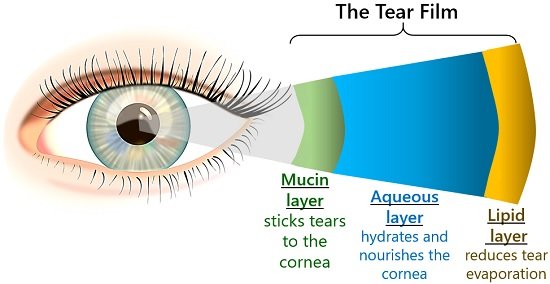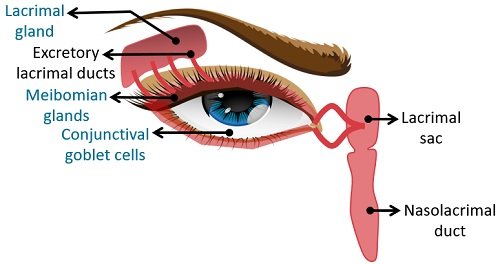Do you know the facts about tears? Tears generally fall from our eyes when we feel happily overwhelmed, gloomy or irritated by something happening around us. We often link crying to the sad part, but it’s a usual response to a wide range of emotions.
Also, crying is a phenomenon that keeps your eyes healthy because the tears keep the eyes lubricated, remove irritants and make us feel better. But, tears become a problem when eyes become excessively dry or watery.
A dry eye is a clinical condition when the eyes are dry enough that tears do not drain out of the eye system. Conversely, a watery eye or Epiphora is a clinical problem when tears often fall out from the eye system.
Do you know what tears are and what layers they consist of? Which ducts participate in the production of tears? How many types of tears can humans produce? Well, these are some general questions that first come to our minds.
This post highlights all the interesting, phycological and hidden facts about tears. Moreover, we will discuss what functions a tear film perform in maintaining eye health and the flow of tears from the eyes.
Content: Facts About Tears
What are Tears?
A tear film is also called a preocular tear film or lacrimal layer. It refers to a thin fluid screening the ocular surface and made of lipid, aqueous and mucin layers.

The lacrimal layer has a thickness of 3 μm and a volume of 3 μl. It is present in the interface of the eye surface and the surrounding. A tear film forms the second line of ocular surface defence after the eyelids.
Tears Facts
This content will enlighten you with some general, psychological and hidden facts about tears.
Fun Facts About Tears
- In general, your eyes produce 15-30 gallons of tears each year.
- Basal, reflex and emotional tears are the three types of tears.
- A tear film is not saline, as it comprises oil, aqueous and mucus layers.
- The biochemical composition of tears is close to the saliva and contains proteins, salts, lipids and hormones.
- Your tears are salty due to the presence of electrolytes.
- Electrolytes in tears include sodium, bicarbonate, chloride, potassium and some traces of magnesium and calcium.
- Lacrimal glands are present above each eye to produce and drain tears out of the ocular surface.
Psychological Facts About Tears
- Sometimes, your nose becomes sniffy when you cry. It is because your tears overflow through your nasal passages down to the nose.
- Sometimes, people shed tears while yawning. A momentary tension develops in the eye’s glands when you yawn and tears spill from your eyes instead of passing through the tear ducts.
- The first drop of happy tears comes from the right eye. In contrast, the first tear drops come from the left eye when you are in pain. And tears come from both eyes at the time of frustration.
- Babies don’t shed tears until they reach one month.
Hidden Facts About Tears
- On average, babies cry for 1 to 3 hours each day for different reasons to communicate their hunger, thirst, tiredness or discomfort. Babies with excessive crying behaviour might have colic.
- In space, astronauts cannot cry, or tears can’t flow due to zero gravity.
- Tear ducts may get blocked due to ageing or any infection, inflammation, or cyst in the nose.
- The tear film has viscoelastic properties, i.e. it is a viscous fluid. This property of the tear film supports all types of eye movements.
- In a healthy eye, the evaporation of precorneal tear film evaporates occurs after 15 to 30 seconds.
- The lacrimal tear should be stable or must be regenerated for the overall eye health and vision.
What are Tears Made of?
A tear film has three layers, where each serves its purpose.

- An outer oily or lipid layer reduces evaporation of tears or prevents eyes from drying out. Also, it makes the eyes’ surface smooth and seals tears from flowing over onto the cheek.
- A middle watery or aqueous layer forms a larger portion of the tear film. It is the reason why we find tears watery. It holds vitamins and nutrients that nourish the eye’s epithelial tissues, which are necessary for the proper functioning of the eyes. Also, it keeps the eye moist, clears waste, or fights against foreign bodies and infection.
- An inner or underlying mucus layer promotes tear film stability by binding a tear film to the cornea. Mucin is a lubricating material that coats the eye surface or keeps the cornea moist. Any damage to the mucus layer can produce dry patches on the cornea.
Thus, the above three layers together form a tear film, maintain eye health, and ward off infections.
Types of Tears
Some experts categorized the tear droplets into three types.

- Basal tears are secreted continuously by our eyes that clean, moisten, foster and safeguard your cornea. These form a constant shield between the eye and the surroundings, keeping dirt and debris out of an eye system.
- Reflex tears stream out when our eyes come in contact with irritants like onion fumes, smoke, pollen, dust, or bacteria. These tears contain more antibodies to help fight against infection. Our eyes release reflex tears more than basal tears.
- Emotional tears fall out when we experience strong emotion for a certain thing and don’t know how to react to joy, sadness, fear and other emotional states.
The basic composition of tears has enzymes, lipids, electrolytes and metabolites. However, emotional tears have a slightly different composition as they contain additional hormones and proteins.
Which part of the eye produces what tear layer?
We have three separate glands responsible for creating good-quality tears. Meibomian glands of eyelids produce the oil layer in our tears. Serous acini tissues in the lacrimal gland secrete the aqueous component of a tear film. The conjunctival goblet cells produce the mucus with contributions from the lacrimal glands.

Functions of Tears
Tears perform a wide range of functions. They maintain the eye health of your eyes and help to communicate your emotions. Each time we blink, a protective coating of tears spreads like a tear film over the eye’s ocular surface. The tear film has a significant role in maintaining overall eye health and performs the following tasks:
- Tears moisten the ocular surface and prevent the eye’s epithelial cells from getting dry and damaged.
- The tear film acts as a lubricant that forms a layer on the eye surface, facilitating the movement of the eyelids without any friction.
- Tears form a smooth refracting surface on the cornea so we can see clearly.
- The electrolytes and proteins in the tear film nourish the cornea.
- Tears contain lysozyme, antibodies, and phagocytic cells that work against foreign bodies and avoid microcyst growth on the cornea.
- Tears also remove debris and metabolic waste products from the eye.
- The tear film protects the ocular surface against air pollutants, chemical irritants and temperature changes.
- Tears create an air-tissue interface and provide oxygen to the avascular cornea.
Pathway of Tears
The time we blink, a teardrop spreads across the eye surface, forming a thin tear film. Then, tears drain into tiny holes in the edges of your upper and lower eyelids near the nose. These openings or little holes are called puncta that behave as small outlets or drainage systems.
Through puncta, your tears travel across small canals (canaliculiin) to a lacrimal sac (on the side of the nose). Your tears then move down to a nasolacrimal duct and drain into your nose.

The lacrimal apparatus aids the production and drainage of tears. To do so, the lacrimal apparatus has three different systems that are as follows:
- First, the secretory system secretes the tear film components.
- Then, the distribution system spreads the tear fluid that covers the corneal epithelium during blinking.
- At last, the excretory system, i.e. the tear or lacrimal ducts, drains the tear fluid out of the eye.
Conclusion
Thus, tears are one of the body fluids secreted by almond-shaped lacrimal or tear glands. There are many hidden and interesting facts about the tears that we discussed here.